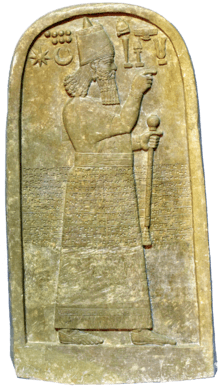Ashur-dugul
Aššūr-dugul, inscribed maš-šur-du-gul, “Look to (the god) Aššur!”, was the king of Assyria probably during the 18th century BC, a period of confusion in Assyrian history. Reigning for six years, he was the 44th ruler to be listed on the Assyrian Kinglist, and was designated by the list as a usurper, overthrowing the Amorite Mut-Askur, who was seen as a foreigner and vassal of Babylon.[1]
Biography
He seized power in the aftermath of the overthrow of the dynasty first established by Šamši-Adad I, when native warlords jockeyed for power in the vacuum left by its demise. Šamši-Adad had been an Amorite who founded a brief, foreign dynasty which was apparently greatly resented by the locals. This resentment is attested by an alabaster slab inscription left by Puzur-Sîn, an otherwise unattested Assyrian monarch who had deposed the son of Asinum, descendant of Šamši-Adad.[2] The Assyrian Kinglist[i 1][i 2] says of Aššūr-dugul that he was a “son of a nobody, without right to the throne” meaning that he was not of royal descent and consequently unqualified to govern according to the patrilineal principle of legitimacy relied upon by later monarchs.
During his reign six other kings, “sons of nobodies also ruled at the time.” This may suggest a fragmentation in the small Assyrian kingdom, with rival claims to the throne. Alternatively, Newgrosh proposes that these may actually have been his limmu’s, the officials appointed each year who gave the year its name, providing the eponym dating system, and that a later scribe may have confused them for kings.[3] The last of these, Adasi, was to go on to found the succeeding dynasty. Apart from the two copies of the kinglist, there are no other extant references to him.
He was succeeded by Bēl-bāni, the son of Adasi.
Inscriptions
- Khorsabad Kinglist, tablet IM 60017 (excavation nos.: DS 828, DS 32-54), ii 4–6.
- SDAS Kinglist, tablet IM 60484, ii 8–9.
References
- K. Åkerman (1998). "Aššūr-dugul". In K. Radner (ed.). The Prosopography of the Neo-Assyrian Empire, Volume 1, Part I: A. The Neo-Assyrian Text Corpus Project. pp. 179–180.
- A. K. Grayson (1972). Assyrian Royal Inscriptions. Otto Harrassowitz. pp. 29–30.
- Bernard Newgrosh (2007). Chronology at the crossroads: the late bronze age in western Asia. Matador. p. 226.
| Preceded by ? Puzur-Sîn |
King of Assyria 18th century |
Succeeded by Bēl-bāni |
